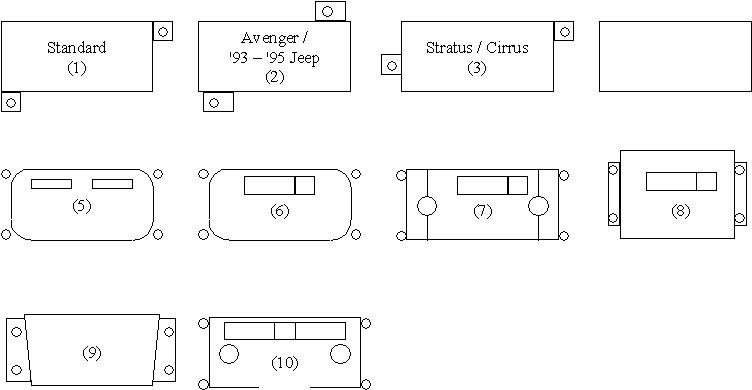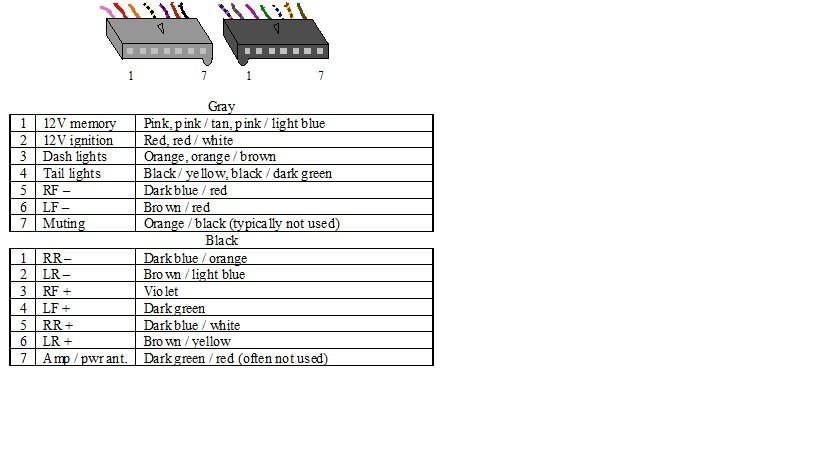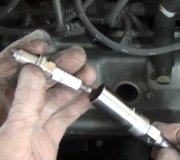Hi guys. You're right, Steve. Supplier number 7910 is Chrysler and 28046 is Mitsubishi. Chrysler only makes the real low-end stuff. Those are the basic models that provide sound so you don't have to sing to yourself. (My friends and neighbors seem to appreciate it when I don't sing)! Mitsubishi makes the high-end stuff. I've found those to be of the highest quality, but they do have a few common problems that will occur to all of them. Once those are repaired, they're repaired for life. Those problems will rarely act up again.
Supplier number 26777 is Alpine. Those are also usually used with high-end systems but I'm not fond of their products, mainly because Alpine refuses to allow the service centers to sell us service manuals or parts for their products built for Chrysler and Toyota. That's the same selfish mentality GM and Ford went to in the mid '90s. If I can't buy their service manuals, I won't buy their products either.
Gary, I'm not sure what you're asking, so let me start off with a few observations. The Mitsubishi CD / cassette combo radio is my number one seller for people wanting to upgrade in a used car they just bought. Even if you don't have cassettes, that is the best radio by far. The CD-only version is built by Alpine. There are about a dozen different model numbers that all look the same and have similar features, but I don't recommend them. GM CD players had a 100 percent failure rate of their laser assemblies all through the 1990s. Out of over 2,000 Chrysler radios I worked on over a 20-year period, I only ran into five weak lasers in the Alpine CD players, but that is still enough to leave a bad taste in my mouth. I have never had a bad laser unit in a Mitsubishi radio. Every "CD Err" problem I've ever had with those was solved by cleaning the laser lens. They're always right up on top where all you have to do is pop off the top cover to get to it. Alpine CD mechanisms are buried under other circuit boards and are time-consuming to get to, and do-it-yourselfers often damage connector pins when trying to put those boards back in place.
The next wondrous point of interest is with any GM or Ford radio, they must be used with or without an amplifier as they were designed. If the radio uses a remote amp, it has to be used with an amp. If if didn't come with a remote amp, it can't be used with a remote amp. Chrysler radios are different. Every radio puts out speaker-lever output and will run speakers directly. They can also be used with a remote amp because Chrysler amps do not increase volume or power. They are used strictly for tone conditioning for the shape of the car body. These systems with amps were called the "Infinity" systems. GM and Ford have different radio model numbers for each car model. They have minor differences in their output circuitry to tailor the tone response. Other than that, they are all pretty much the same, and will plug into other car models. You might find 50 different model numbers for GM for one year, so it is common to get a replacement from a salvage yard that is different than what you are replacing, yet it will work fine. Ford's radios list the car model right on their radios, but again, they will still work in other models.
The next clinker with Chrysler amps is there are two versions. Beginning in the late '80s, those amps were bolted right to the speakers. They developed a problem that resulted in total loss of bass, intermittent loss of bass, buzzing, or popping, and those symptoms commonly changed when you removed the speaker from the dash, door, or lift gate, and held it in a different orientation. The question always was, is it the radio or the amp?" The clue was to switch the two mating speakers side-to-side, then see if the problem followed the speaker or stayed in the same location. Door speakers were the most confusing because by moving a defective speaker to the other door, it was upside down now compared to before, and that could cause it to work okay, or it could cause the other one to start acting up. When the problem stayed in the same door after switching the speakers, it was usually caused by broken or frayed wires between the door hinges. I've repaired about a dozen Infinity speakers over the years, including two in the lift gate of the '94 minivan I'm driving now. These too are usually fixed for life. The problems are caused by insufficient solder due to automated soldering techniques. Most of these amps use circuit boards that are sealed in a protective jelly. It takes a long time to remove that stuff to get to the bad connections.
By the early '90s, they started using a single remote amplifier instead of the individual ones on the speakers. Those have been uncommonly reliable. They were mostly built by Harmon, and I can't get service manuals for them either. One exception to that reliability seems to be those used in the Stratus / Cirrus. By 2002 I was no longer at the dealership, so I can't say for sure about your car, but in the earlier years, that amp was mounted on the floor under the front passenger seat. The problems with those were related to water / moisture, and probably salt on the passenger's shoes.
The next thing to cause confusion is 1999 through 2003 is where there was a lot of change-over between face plates and plugs. If you look at my nifty drawing, style number one was used from the mid '70s through 1998 on most models, and until 2003 on full-size vans. Styles two and three are shown with their special mounting ears and applications. All of these used two seven-pin plugs, one gray and one black. The '70s through mid '80s models used different plugs, but by the late '80s if you have any "square-face" model, it uses those two plugs. The wire colors could vary a little, but for the most part, they were standardized over all those years and car models. Notice terminal 7 in the black plug gets 12 volts switched onto it when the ignition switch and the radio are turned on. That is the wire that tells a power antenna to go up, and / or an amp to turn on. That wire was often missing on the base model cars up to the mid '90s. If you upgrade to an Infinity system, you could find a plug in a salvage yard, pop the terminal out and stick it in your black plug. In later years that wire was already there, even when it wasn't used.
Some of these Mitsubishi and Alpine-built radios also have a two-pin white plug with just one terminal inside it. As I recall, that was for cars with steering wheel controls. Nothing has to be plugged into that, and if your car has that plug hanging there, it doesn't have to be plugged in to anything.
1999 was the first year they switched to the "round-face" face plate design. That was style number 5, but it still used the same two plugs. Those were found in the Neons. Every year a few more car models switched to that face plate, but by 2004, all had switched to style number 6. They look the same and have the same four mounting holes. Only the plug design changed to a single white plug with two rows of terminals. This plug also has two ground wires in it. The old gray and black plugs didn't have a ground wire in them. That led to lots of blown tail light or dash light fuses when people mistakenly found those with an ohm meter and thought they were ground wires. Those older radios were grounded with a bolted-on braided strap or a plugged-in ground wire.
Before I forget, when those older systems used little amps on the speakers, there were usually four of them. To handle the current, instead of the switched 12 volts coming out of the radio, the current came from a relay and that relay was switched on by the radio. The ground wire for that relay's coil was clipped to the back of the radio on the full-size vans, and possibly some other models. When we were accustomed to needing that ground strap on the radio, when plugging in a test radio temporarily, it was common to not bother with that clipped-on ground wire since the radio's display was already on. With that second ground wire not connected, the "speaker" relay wouldn't turn on, and all we would hear is the faint treble. Those Infinity speakers are two-way, and the tweeter didn't go through the amps, so we could still hear those when the amps were not turned on. Forgetting that simple clipped -on ground wire led to a lot of misdiagnosis.
In style 6, the second smaller plug is for a remote-mounted four or six-disc CD changer. The six-disc units, whether remote-mounted, or built-in in later years, is a real tough unit. It goes into "lock" mode for shipping when power is removed. To unlock it, you just plug it in. The four-disc is a different story. Both the built-in and the remote-mounted versions require use of four shipping screws to be installed to prevent something from shifting and going out-of-time. If you buy one of these on eBay and it comes with no shipping screws, you have a 50 percent chance it will not work, and a 99 percent chance it won't work if it comes by the UPS basketball team. I have the service manuals for these, but they're just four pages of schematic diagrams. No parts lists or mechanical diagrams. I haven't had time yet to sit down with a good unit and a bad one to compare what is different. The only CD changer mechanism that is a lot worse is Ford's six-disc unit built into the radio. Those have a sticker on them that says, "scrap if dropped", and they mean it. Those rarely survive shipping unless they have the huge, bulky metal bracket inserted, which no one has.
The most common radio model for your car was P04858540AH or AJ. There are other models that will work but I can't say which were used with or without an amp. With the older square-face radios, you could have two sitting side-by-side, and the one that was meant to be used with an amp said, "Infinity" on the front. They didn't do that with the round-face radios. The radios meant to be used with an amp put out less bass than the standard radios. That bass is made up in the amps. For that reason, if you install a low-end radio into a vehicle that has an amp, it will have too much bass unless you turn that tone control way down. Since Infinity radios put out less bass, if you put one of those in a car that doesn't have an amplifier, you'll have too little bass unless you turn the bass control all the way up. Most people can't even notice the difference, but it is still worth mentioning.
One final word about speakers. The Infinity speakers with bolted-on amps are usually 6" x 9" or 6" round. There are smaller speakers, say around 5" x 7" that also have a small black plastic box bolted to them, but those are not amplifiers. Those are just cross-over networks, and the speaker has a separate tweeter mounted inside the woofer. I ran into a few of these that were intermittent and acted like they had bad solder connections, but they turned out to have bad capacitors. The circuit boards were not sealed in protective jelly so they were easy to get apart. To tell the difference, these speakers with cross-over networks have the standard two wires in their plugs. Infinity speakers have four wires. Two are for the speaker and one is a 12-volt feed to run the amp and the other is the amp's ground wire. When used in a door or lift gate, and a speaker is dead, always consider the possibility of broken wires between the hinges. If you can use two jumper wires to run a standard speaker, and it works, check if you have 12-volts on the red wire in the plug, and check the ground wire for voltage or continuity. If both are okay, then suspect the speaker. The two speaker wires are the middle two in the plug. To check the ground wire, unplug the plug, then use an ohm meter to check continuity to ground on the black wire. An alternative is to check for voltage on the ground wire, but that has to be done with the plug connected to the speaker. If you find any voltage on that wire, it's because it is broken before it bolts to the body. Ground wires will always run between the hinges, then will be bolted to the body. They never rely on the painted hinge pins to make a reliable ground.
Images (Click to make bigger)
Saturday, January 12th, 2019 AT 6:19 PM






